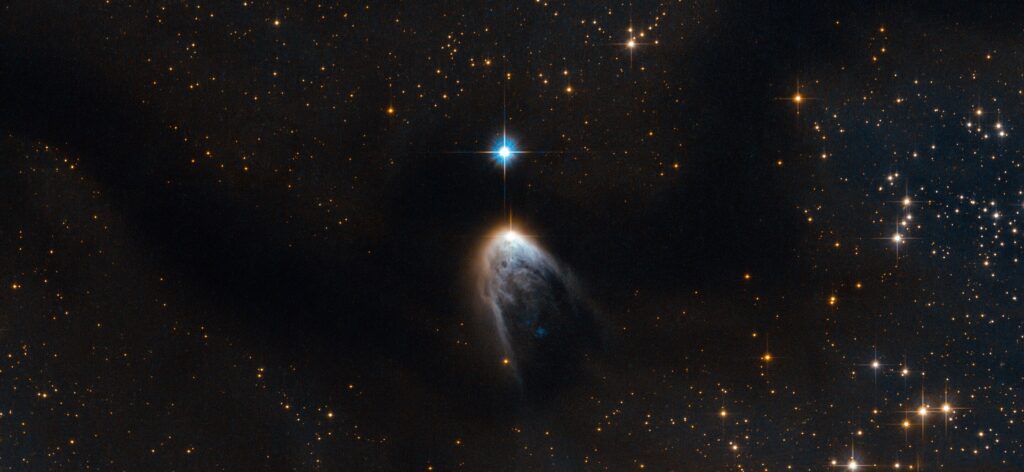Greetings, cosmic explorers! Captain Nova here, transmitting from the Odyssey Explorer on Day 21 of our “100 Days of Space Exploration” journey. Today, we’re delving into one of the most fundamental and awe-inspiring processes in the universe: the birth of stars. Stars are the beacons of the cosmos, illuminating the vast darkness of space and serving as the building blocks for galaxies, planets, and even life itself. But how do these celestial giants come into existence? Buckle up as we explore the science of stellar formation!

The Birthplace of Stars: Giant Molecular Clouds
Stars are born in vast cosmic nurseries known as giant molecular clouds. These immense clouds of gas and dust, often spanning hundreds of light-years, are composed primarily of hydrogen, the most abundant element in the universe. These regions, sometimes called nebulae, are cold and dense, making them ideal sites for star formation. Some of the most famous stellar nurseries include the Orion Nebula, the Eagle Nebula (home of the “Pillars of Creation”), and the Carina Nebula.
The Trigger: What Sets Star Formation in Motion?
A molecular cloud on its own remains relatively stable, but certain events can trigger the collapse of gas and dust, setting the stage for star formation. These triggers include:
- Shockwaves from Supernovae: When a massive star reaches the end of its life and explodes in a supernova, the resulting shockwave compresses nearby gas, initiating star formation.
- Galaxy Collisions: When galaxies interact or collide, the gravitational forces stir up gas and dust, leading to intense bursts of star formation.
- Radiation from Nearby Stars: Powerful ultraviolet radiation from massive young stars can compress surrounding gas, prompting new stars to form.
- Turbulence and Gravitational Instability: Within a cloud, turbulence can create pockets of dense gas that collapse under their own gravity.
The Collapse: Gravity Takes Over
Once a region within a molecular cloud becomes dense enough, gravity pulls the gas and dust inward, causing the material to clump together. This process forms a protostar, a young star still gathering mass from its surroundings. As the protostar continues to collapse, the temperature and pressure in its core rise dramatically.
During this phase, the protostar is often surrounded by a swirling disk of gas and dust, known as an accretion disk. This disk not only feeds the growing star but also plays a crucial role in the formation of planets, moons, and other celestial objects.
The Ignition: Nuclear Fusion Begins
As the protostar contracts, its core temperature eventually reaches about 10 million Kelvin. At this point, nuclear fusion ignites: hydrogen atoms fuse to form helium, releasing an enormous amount of energy in the process. This marks the birth of a true star! The outward pressure from the fusion-generated energy balances the inward pull of gravity, achieving a stable state known as hydrostatic equilibrium.
Different Types of Stars and Their Formation
Not all stars are created equal. The mass of the protostar determines what kind of star it will become:
- Low-Mass Stars (Red Dwarfs): These are the most common type of stars in the universe. They burn fuel slowly, giving them lifespans of up to trillions of years.
- Sun-Like Stars (Yellow Dwarfs): Our Sun falls into this category. These stars have moderate lifespans of about 10 billion years before evolving into red giants.
- Massive Stars (Blue Giants and Supergiants): These behemoths burn their fuel rapidly, often living only a few million years before going supernova.
Star Clusters: Stellar Communities
Stars often form in groups rather than in isolation. These groups, known as star clusters, come in two main types:
- Open Clusters: Loose groups of young stars that formed from the same molecular cloud, like the Pleiades.
- Globular Clusters: Densely packed, spherical groups of ancient stars, often found in the halos of galaxies.
The Bigger Picture: Star Formation in Galaxies
Star formation isn’t just an isolated process—it plays a crucial role in the evolution of galaxies. Spiral galaxies, like our Milky Way, have active star-forming regions in their arms, while elliptical galaxies, composed mostly of older stars, have little to no star formation.
Massive galaxies often contain starburst regions, areas where new stars are being formed at an exceptionally high rate, often triggered by interactions with other galaxies.
The Cosmic Cycle: Recycling Stardust
Stars are part of a continuous cosmic cycle. When they reach the end of their lifetimes, they return enriched material to the interstellar medium. The elements formed in stars—carbon, oxygen, iron—become part of new generations of stars and planets. In fact, the very atoms in our bodies were forged in the hearts of ancient stars, making us all children of the cosmos.
Looking Ahead
Tomorrow, we continue our journey by exploring the Life Cycle of a Star: From Birth to Death. We’ll follow a star’s entire journey, from its glowing infancy to its ultimate fate as a white dwarf, neutron star, or even a black hole.
Until then, keep your eyes on the stars and your curiosity burning bright!
Captain Nova
Odyssey Explorer
Leave a Reply